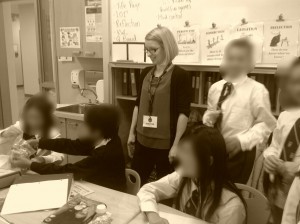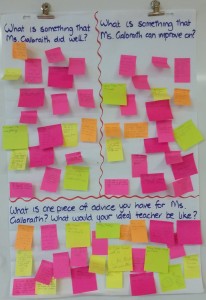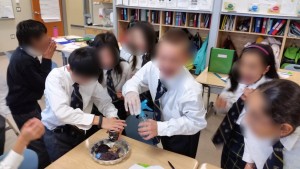Student-centered
 Having been trained through the IB cohort at UBC, student-centered learning has always been a large component of our work. What’s more, being subject to transmission-style teaching through my own primary and secondary education, I can understand the importance of a student-centered approach and how much it can impact retention of concepts. Participating in individual inquiry projects, genius hour, and exhibition are ways in which I hope to encourage the student to take ownership of their learning. Students may design the classroom layout, decide how the room will be decorated, or with the change in the new BC curriculum providing more flexibility, they may even get to choose some of the content. My hope is that giving students a choice and allowing them to provide input will result in an engaged, collaborative and respectful classroom. Personalized learning and differentiation are concepts which I am mindful of also attempting to master throughout my practicum, most of which comes through really knowing your students interests, strengths and weaknesses (as discussed in my teaching philosophy).
Having been trained through the IB cohort at UBC, student-centered learning has always been a large component of our work. What’s more, being subject to transmission-style teaching through my own primary and secondary education, I can understand the importance of a student-centered approach and how much it can impact retention of concepts. Participating in individual inquiry projects, genius hour, and exhibition are ways in which I hope to encourage the student to take ownership of their learning. Students may design the classroom layout, decide how the room will be decorated, or with the change in the new BC curriculum providing more flexibility, they may even get to choose some of the content. My hope is that giving students a choice and allowing them to provide input will result in an engaged, collaborative and respectful classroom. Personalized learning and differentiation are concepts which I am mindful of also attempting to master throughout my practicum, most of which comes through really knowing your students interests, strengths and weaknesses (as discussed in my teaching philosophy).
 One of my personal strengths is in my reflective nature, and my willingness to seek out regular feedback from peers AND students. I encourage colleagues to provide me with constructive feedback, and for each classroom I enter, I like to ask my students what they value in a teacher, giving me insight on my context-based pedagogy, as well asking for honest feedback at the end of each practicum. When I did this during my first practicum, students were remarkable insightful and were able to identify what they liked and where I needed to improve – adding much value to my development as a teacher. When I have a regular classroom, my hope is to do this frequently throughout the year. On top of this, I regularly reflect on lessons during and after the fact… this awareness allows me to be flexible and adapt lessons in the moment based on student needs, as well as make changes for future lessons based on successes and failures. This capability will allow me to maintain a student-centered approach, while pushing myself to grow and develop as an educator.
One of my personal strengths is in my reflective nature, and my willingness to seek out regular feedback from peers AND students. I encourage colleagues to provide me with constructive feedback, and for each classroom I enter, I like to ask my students what they value in a teacher, giving me insight on my context-based pedagogy, as well asking for honest feedback at the end of each practicum. When I did this during my first practicum, students were remarkable insightful and were able to identify what they liked and where I needed to improve – adding much value to my development as a teacher. When I have a regular classroom, my hope is to do this frequently throughout the year. On top of this, I regularly reflect on lessons during and after the fact… this awareness allows me to be flexible and adapt lessons in the moment based on student needs, as well as make changes for future lessons based on successes and failures. This capability will allow me to maintain a student-centered approach, while pushing myself to grow and develop as an educator.
Risk-taking & Resilience
 Risk-taking and resiliency are qualities that I hugely value in my life. Part of this is due to my experience in mental health: most of the time, we as teachers cannot control the risks that our students will be exposed to throughout their lives, but we can help build the skills to help them manage these situations as best they can. But more than this I believe having resiliency allows students to push themselves to engage in much greater and challenging encounters, which in turn results in more significant learning experiences. When I think back to my own practicum, I was immediately labelled as a ‘risk-taker’ by taking on much more than was expected. I have no doubts that this provided me with much more valuable lessons. Consequently, this is an attitude and skill that I would like to pass on to my students. Starting off the year with a lesson on ‘Rebranding Failure’; making growth-oriented goals; modelling that it is okay to make mistakes; and facilitating a growth mindset through formative assessment and reflection, are some of the ways I aim to create a risk-taking community. In achieving this, I can continue to set high expectations, and through providing additional support when needed, we can push our students to see how far they can go. They might just surprise us!
Risk-taking and resiliency are qualities that I hugely value in my life. Part of this is due to my experience in mental health: most of the time, we as teachers cannot control the risks that our students will be exposed to throughout their lives, but we can help build the skills to help them manage these situations as best they can. But more than this I believe having resiliency allows students to push themselves to engage in much greater and challenging encounters, which in turn results in more significant learning experiences. When I think back to my own practicum, I was immediately labelled as a ‘risk-taker’ by taking on much more than was expected. I have no doubts that this provided me with much more valuable lessons. Consequently, this is an attitude and skill that I would like to pass on to my students. Starting off the year with a lesson on ‘Rebranding Failure’; making growth-oriented goals; modelling that it is okay to make mistakes; and facilitating a growth mindset through formative assessment and reflection, are some of the ways I aim to create a risk-taking community. In achieving this, I can continue to set high expectations, and through providing additional support when needed, we can push our students to see how far they can go. They might just surprise us!
Inquiry-based
 IB embodies inquiry-based learning, but what’s even more exciting, is that education in general is making a shift towards this (as evidenced through the new curriculum). Content and knowledge is still important, but the process of learning, problem-solving, and developing the skills needed to become curious lifelong learners is what ‘schooling’ is now all about. Inquiry allows us to develop these skills, tapping into student interests to understand the big ideas through DOING. Teaching kids how to ask great questions, and setting students up for success by creating hands-on, experiential learning conditions gives students the opportunity to immerse themselves in their learning, and makes for a more engaged, lively classroom culture.
IB embodies inquiry-based learning, but what’s even more exciting, is that education in general is making a shift towards this (as evidenced through the new curriculum). Content and knowledge is still important, but the process of learning, problem-solving, and developing the skills needed to become curious lifelong learners is what ‘schooling’ is now all about. Inquiry allows us to develop these skills, tapping into student interests to understand the big ideas through DOING. Teaching kids how to ask great questions, and setting students up for success by creating hands-on, experiential learning conditions gives students the opportunity to immerse themselves in their learning, and makes for a more engaged, lively classroom culture.
Related to this, for me, learning needs to be purposeful and action-oriented, otherwise ‘what’s the point’? Providing real-world application will allow students to make connections and build upon their prior learning. What’s more, in my classroom I will try and provide as many opportunities as possible for my students to apply their learning in a way that allows them to take real-world action as they develop their international mindedness. This could vary between producing an outcome that is visible and purposeful, to taking real action to make change in their classrooms, schools, and larger communities.
